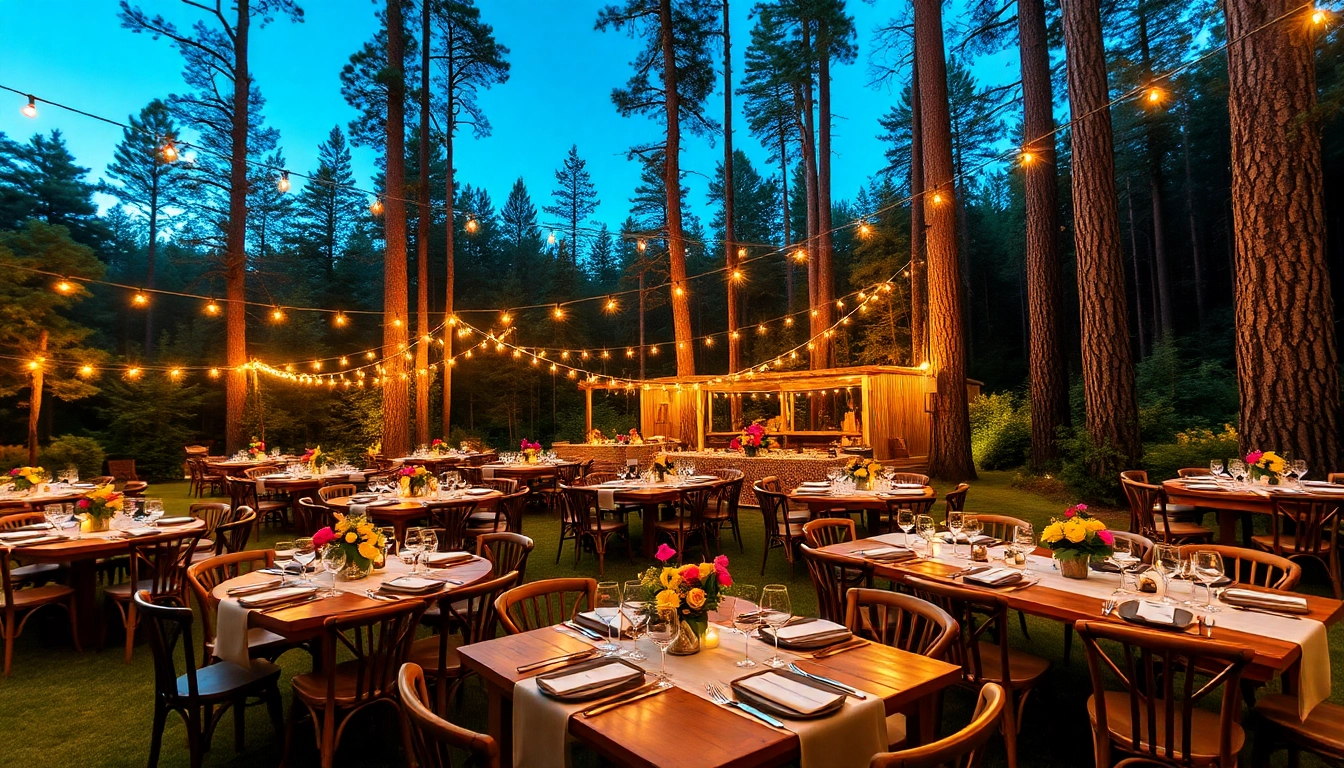Introduction to Wildfire Events
Wildfire events encompass gatherings, exhibitions, or activities that center around the themes of fire safety, community awareness, and ecological conservation related to wildfires. As an increasingly pressing global issue, wildfires have dominated headlines, stressing the importance of effective management and community involvement. Engaging in wildfire events can serve to inform, educate, and encourage action among individuals and communities. This article will delve into the importance, planning processes, strategies, safety measures, and assessment of wildfire events, helping you to create impactful and meaningful gatherings.
What Are Wildfire Events?
At their core, wildfire events are initiatives designed to bring awareness to the dangers posed by wildfires and promote readiness and resilience among communities. These events can take many forms, ranging from educational seminars and workshops to large-scale community outreach festivals and support programs. The overarching aim is to minimize risks associated with wildfires by spreading knowledge regarding safety protocols, prevention strategies, and emergency responses.
The Importance of Hosting Engaging Gatherings
Hosting wildfire events allows communities to come together and address fire-related challenges collectively. Engaging gatherings foster collaboration among residents, firefighters, local governments, and environmental organizations, ensuring that diverse perspectives are considered. By sharing experiences, resources, and insights, communities can cultivate stronger protective measures against wildfires and enhance their overall preparedness. Additionally, these events can play a crucial role in forming a culture of awareness about fire environments, encouraging public participation in safety initiatives.
Popular Types of Wildfire Events
There are several types of wildfire events that cater to various audiences and objectives:
- Workshops: Hands-on sessions that teach participants about fire safety, prevention, and management techniques.
- Public Awareness Campaigns: Events designed to disseminate information about wildfire risks and safety measures through flyers, social media, and community gatherings.
- Fundraisers: Events that support local fire departments or environmental organizations dedicated to wildfire education and management.
- Retreats and Community Gatherings: Opportunities for residents to connect, share experiences, and learn from one another while focusing on wildfire preparedness.
- Educational Seminars: Expert-led discussions that cover the latest research and strategies for wildfire management and mitigation.
Planning Your Wildfire Events
The planning phase is crucial for a successful wildfire event. Understanding the goals, audience, and logistics will help ensure that the event meets its objectives and makes a meaningful impact on the community.
Setting Goals for Your Event
Begin by defining clear, measurable goals for your wildfire event. What are you hoping to achieve? Possible objectives include:
- Raising awareness about wildfire prevention.
- Educating participants about safety measures.
- Fundraising for local fire response initiatives.
- Fostering community engagement and collaboration.
By establishing specific goals, you can tailor your event to address the identified needs of your community.
Identifying Your Audience
Understanding your target audience is essential for crafting a successful wildfire event. Different demographics may require different approaches, messaging, and engagement strategies:
- Residents: Targeting local families, homeowners, and property managers helps communicate practical safety tips and resources.
- School Students: Organizing educational workshops for schools instills awareness in younger generations and encourages their families to participate.
- Local Businesses: Engaging local corporations can produce partnerships and sponsorships while promoting corporate social responsibility.
- Firefighting Professionals: Collaborating with firefighters can provide authentic insights and build trust within the community.
Once you identify your audience, you can tailor the event’s content and presentation style accordingly.
Choosing the Right Location
The venue plays a significant role in the success of your wildfire event. Consider the following factors when selecting a location:
- Accessibility: Ensure the venue is easily accessible for all participants, including individuals with disabilities.
- Capacity: Choose a venue that can comfortably accommodate your expected audience size.
- Relevance: Sites that hold historical significance in relation to wildfire events can provide a compelling backdrop for discussions.
- Safety: Confirm that the location adheres to local safety codes and emergency preparedness protocols.
Based on these criteria, select a venue that aligns with the goals and requirements of your event.
Strategies for Successful Wildfire Events
Effective implementation of engaging strategies will enhance the overall experience for attendees and contribute to the event’s success. Below, we outline several approaches to consider.
Creating an Inviting Atmosphere
Establishing a welcoming environment is essential for encouraging participation. Consider employing the following techniques:
- Friendly Check-in Procedures: Simplify the process for attendees upon arrival to enhance their early engagement.
- Decor and Themes: Utilize decorative elements that evoke the themes of nature and fire safety to create an ambiance that reflects the event’s purpose.
- Comfortable Seating Arrangements: Ensure seating is comfortable and conducive to discussions, networking, and learning.
- Interactive Stations: Create areas where attendees can engage in hands-on activities related to fire safety and preparedness.
By ensuring a welcoming atmosphere, you’ll encourage participants to feel at ease, fostering engagement and connection.
Engaging Activities to Include
Incorporating a variety of activities into your event will make it more interactive and enjoyable:
- Workshops: Run practical, hands-on sessions that teach essential skills related to wildfire management.
- Fire Safety Demonstrations: Live demonstrations by firefighters can illustrate critical safety protocols and emergency response techniques.
- Breakout Group Discussions: Facilitate small-group discussions on pertinent themes related to wildfires and prevention methods.
- Interactive Quizzes: Create fun quizzes and games that test participants’ knowledge about wildfire facts and safety protocols.
Finally, consider offering incentives for participation, such as giveaways or raffle prizes, to stimulate engagement.
Effective Promotion Techniques
Promotion is key to maximizing attendance and generating interest in your wildfire event:
- Social Media Campaigns: Utilize platforms like Facebook, Instagram, and Twitter to announce event details and engage with potential attendees.
- Community Outreach: Collaborate with local organizations, schools, and businesses to spread the word and encourage collective participation.
- Email Newsletters: Send regular updates and reminders via email to keep the community engaged in anticipation of the event.
- Media Coverage: Invite local news outlets to cover the event, providing added visibility and credibility.
By utilizing various promotional avenues, you’ll increase your event’s chances of success.
Best Practices for Safety During Wildfire Events
Ensuring the safety of all participants during wildfire events is paramount. Implementing effective safety protocols and educational initiatives can safeguard attendees and promote a culture of preparedness.
Understanding Fire Risks and Safety Protocols
Educate attendees about potential wildfire-related threats. Discuss the various factors that contribute to fire risks, such as weather conditions, vegetation, and local terrain. Additionally, communicate safety protocols in an accessible format:
- Emergency evacuation routes and procedures.
- Locations of fire extinguishers and first aid kits.
- Contact information for local emergency services.
Provide handouts summarizing this information so that participants can refer to it after the event.
Emergency Preparation and Response Plans
Develop comprehensive emergency plans to address unforeseen circumstances that may arise during the event. Consider these guidelines:
- Risk Assessment: Evaluate the venue for fire hazards and ensure proper mitigation measures are in place.
- Coordination with Local Authorities: Establish relationships with local fire departments and emergency services to ensure effective communication during emergencies.
- First Aid Training: Train staff and volunteers on basic first aid and emergency response procedures.
- Communication Plans: Create protocols for communicating rapidly and effectively with attendees in the event of an emergency.
Educating Attendees on Fire Safety
Integrate fire safety education into your event programming. Offer sessions that help attendees understand how to protect themselves and their property:
- Presentations by Fire Safety Experts: Host qualified speakers to discuss pressing topics, trends, and techniques in wildfire safety.
- Resource Sharing: Provide take-home materials and resources that reinforce safety messages and best practices.
- Behavior Change Campaigns: Encourage attendees to adopt preventative behaviors related to fire safety and risk management.
Overall, arming your attendees with knowledge empowers them to take charge of their safety.
Measuring Success of Your Wildfire Events
To assess the efficacy of your wildfire event, implement measures that evaluate both immediate outcomes and long-term impacts. By doing so, you can refine future gatherings to enhance their value.
Gathering Feedback and Evaluating Performance
Solicit feedback from attendees through various channels:
- Post-Event Surveys: Distribute surveys via email or social media to gather insights on participant experiences.
- Direct Interviews: Conduct brief interviews with select attendees to gain deeper insights into their perceptions and suggestions.
- Observation: Note interactions and overall participation levels during the event to gauge engagement levels.
By prioritizing feedback, you can continuously improve your events and better meet the needs of your audience.
Using Metrics to Improve Future Events
Track key performance indicators (KPIs) to evaluate the success of your wildfire event:
- Attendance Numbers: Measure the number of participants compared to your expectations and goals.
- Engagement Levels: Monitor interactions during demonstrations, workshops, and discussions to assess enthusiasm and engagement.
- Media Coverage: Document any press coverage to evaluate the visibility and reach of your event.
Use these metrics as benchmarks for future events to assess growth and success over time.
Case Studies of Successful Wildfire Events
Examining real-world examples of successful wildfire events can provide insights and inspire future initiatives:
- The Wildfire Awareness Week: A week-long series of events across several municipalities that included educational workshops, fire safety demonstrations, and community outreach programs, leading to a significant increase in local fire safety awareness.
- National Fire Safety Day: A collaborative effort organized by local governments and fire departments that incorporated engaging activities for families, including hands-on demonstrations and interactive booths. This event saw heightened community engagement and partnerships.
- School-based Fire Safety Programs: Implemented in several schools, these programs educated students about wildfire risks and safety. The positive feedback indicated improved awareness levels among students and their families, prompting wider community involvement.
These examples highlight the potential impact of well-organized wildfire events in fostering greater community knowledge and preparedness for wildfire situations.









